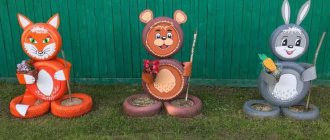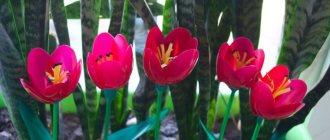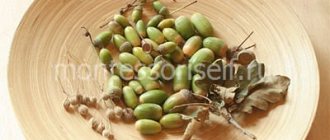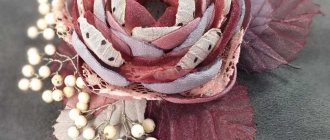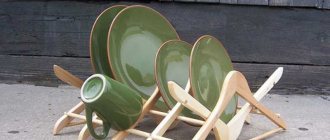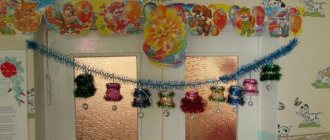Molecules from plasticine. Step-by-step sculpting lesson.
Today we will conduct a lesson not only in modeling, but also in chemistry, and we will make models of molecules from plasticine.
Plasticine balls can be imagined as atoms, and ordinary matches or toothpicks will help to show structural connections. This method can be used by teachers when explaining new material in chemistry, by parents when checking and studying homework, and by children themselves who are interested in the subject. There is probably no easier and more accessible way to create visual material for mental visualization of micro-objects. Here are representatives from the world of organic and inorganic chemistry as examples. By analogy with them, other structures can be made, the main thing is to understand all this diversity.
Materials for work:
1. Prepare plasticine for modeling spherical atoms from which molecules will be formed, as well as matches to represent the bonds between them. Naturally, it is better to show atoms of different types in a different color, so that it is clearer to imagine a specific object of the microworld.
2. To make balls, pinch off the required number of portions of plasticine, knead in your hands and roll into shapes in your palms. To sculpt organic hydrocarbon molecules, you can use larger red balls - this will be carbon, and smaller blue balls - hydrogen.
3. To form a methane molecule, insert four matches into the red ball so that they point towards the vertices of the tetrahedron.
4. Place blue balls on the free ends of the matches. The natural gas molecule is ready.
5. Prepare two identical molecules to explain to your child how the molecule of the next hydrocarbon, ethane, can be obtained.
6. Connect the two models by removing one match and two blue balls. Ethan is ready.
7. Next, continue the exciting activity and explain how a multiple bond is formed. Remove the two blue balls and make the bond between the carbons double. In a similar way, you can mold all the hydrocarbon molecules necessary for the lesson.
8. The same method is suitable for sculpting molecules of the inorganic world. The same plasticine balls will help you realize your plans.
9. Take the central carbon atom - the red ball. Insert two matches into it, defining the linear shape of the molecule; attach two blue balls, which in this case represent oxygen atoms, to the free ends of the matches. Thus, we have a carbon dioxide molecule of linear structure.
10. Water is a polar liquid, and its molecules are angular formations. They consist of one oxygen atom and two hydrogen atoms. The angular structure is determined by the lone pair of electrons on the central atom. It can also be depicted as two green dots.
These are the kind of exciting creative lessons you should definitely practice with your children. Students of any age will become interested in chemistry and will understand the subject better if, during the learning process, they are provided with a visual aid made by themselves.
Source
Creative chemistry lesson for children - structure of the water molecule
There is no need to be afraid of complex terms and incomprehensible phenomena that the fundamental science of chemistry studies. One has only to take a closer look at the world around us and notice some of the processes that are happening around us. Educated people know that all the objects around us, water, air, and ourselves, consist of molecules, and those, in turn, consist of atoms. Even with young children, you can conduct educational conversations and creative lessons that can instill a love for interesting sciences.
Review the structure of a water molecule with your kids. You can make a unique model with your own hands from ordinary plasticine and matches. Using simple examples, it will be possible to show 3 states of aggregation and the shape of a dipole.
Thomson model
The first model of the structure of the atom was invented by the English physicist Joseph John Thomson (who was awarded the Nobel Prize for the discovery of the electron). Ultimately it turned out to be incorrect, but it played an important role in being the impetus for Rutherford's subsequent experimental research. Physicists called Thomson's model "raisin pudding."
According to Thomson, an atom is a ball with a size of the order of cm. A positive charge is distributed in some way throughout this ball, and inside the ball, like raisins, there are electrons (Fig. 1).
Rice. 1. Thomson's atomic model
The total charge of the electrons is exactly equal to the positive charge of the ball, so the atom as a whole is electrically neutral.
The radiation of atoms is explained by the vibrations of electrons around equilibrium positions (as you remember, any accelerating charge emits electromagnetic waves). However, the entire set of experimental data on atomic spectra did not fit into Thomson’s model. For example, for some chemical elements formulas were selected that well described their spectra, but these formulas did not follow Thomson’s model in any way.
Water molecule
All human life is connected with water - from birth to death. Water is one of the very first substances that a little researcher begins to study - in a bathtub, a puddle, and even on the kitchen table. Its unique properties of evaporating, freezing, melting (melting) attract the minds of older children.
But why this happens and what the well-known water consists of is learned only in high school. However, we are inclined to believe that we should not wait until cognitive interest in this substance, unique in its properties, begins to fade. After all, even an older preschooler can understand the concepts of atom and molecule, especially if they make their models with their own hands, based on scientific data (with the help of adults).
Preparatory stage
Before you do a perm at home, you need to prepare for it. Twenty days before the event you cannot dye your hair. It would be a good idea to conduct a drug sensitivity test before perming. To do this, apply a little product behind the ear and wait a day. If no allergic reaction occurs, the product can be used; conversely, if there is irritation or rash, it is better to stop using the drug.
Before this event, you should see how the chemical reagent will act on your hair. To do this, a small curl is treated with a curling compound. If after a couple of minutes the strand breaks, then the concentration of the solution is halved. The procedure is repeated on another strand. If your hair still breaks, then you need to give up perm and pay attention to restoring and strengthening your hair.
All products for this event must match your hair type. For long bobbins, choose a larger diameter, for short ones - a smaller one. Be sure to evaluate the condition of your hair before curling. Weak strands should not be subjected to such an event.
Museum of the Intangible
The world of molecules has traditionally been considered an area accessible only to scientists due to the fact that its ultramicroscopic nature is not subject to sensory perception. Like Plato’s Republic, in which the inhabitants of an allegorical cave judge the real world only by the shadows cast on the walls of their abode, the virtual museum “Intangible” is a collection of “shadows” cast from the world of molecules onto our everyday existence.
Kenneth Eward, the gallery's curator, unexpectedly became interested in art while researching cell physiology, and after graduating from university, he opened his own art salon, BioGrafx, in Manhattan, dedicated to scientific achievements. Evard's virtual collection consists of sculptures of molecules and "molecular landscapes", executed in the "desert" aesthetic manner characteristic of photographers of the early 20th century. “The laws of physics do not necessarily apply in the virtual world, which makes creativity possible, freed from natural limitations,” he writes about his installations.
One of the sculptures in the virtual VRML gallery - a green fluorescent protein (Fig. 4) - vibrates slightly, slightly contracts and expands, at the same time telling the viewer about the dynamic nature of protein molecules and reminiscent of a jellyfish - the organism from which this most important for modern molecular biology was isolated and bioengineering facility.
Figure 4. Green fluorescent protein glows ghostly in the dark. This property is actively used in genetic engineering.
Kenneth Eward, 1998, published with permission of the author
What is around the atom?
To understand how to draw an atom, you need to determine what its appearance is. Electrons, that is, small balls that were drawn in the previous paragraph, move around protons, that is, larger circles. Therefore, they have their own trajectory or path. It is depicted as ellipses that pass through electrons. Ellipses are the route of small particles.
These elongated ovals are placed across the main circle, crossing each other. On average, you can get about three such circles. If it is difficult to draw circles so that they intersect the electrons, then you can first draw these paths and then place the electrons on them.
Now you can erase all the pencil sketches, highlight with a clear line what should remain, and color the atom itself.
In a general sense, the pattern of an atom is a collection of small circles circling around a center of larger balls. This is our atom, and now everyone knows how to draw it. You can color it however you like!
Historical reference
The concept of the atomic structure of matter dates back to antiquity - they are attributed to the philosopher Democritus, who discussed the organization of all things. However, the attention of the scientific world focused on the problem of the structure of matter already in the Middle Ages, when Johannes Kepler thought about the problems of the symmetry of snowflakes and the symmetric packing of spherical objects (a problem also known as Hilbert’s 18th problem, which was solved only recently [1]). At the beginning of the 19th century, John Dalton already spoke of atoms as real particles of different masses and sizes, and closer to the middle of the century, the Austrian scientist Joseph Loschmidt depicted various molecules as a set of touching circles. The creation of the first spatial model of a molecule (it was methane) is attributed to August Wilhelm Hofmann, but the most important concept of chemical science - stereochemistry - was laid down by Jacob Hendrik van't Hoff, who drew attention to the tetrahedral structure of the electron shell of the carbon atom in methane. The development of chemistry and X-ray crystallography led to the most important discoveries in biology of the 20th century - the establishment of the spatial structure of DNA and protein molecules - and the problem of adequately representing the structure of biological molecules, especially complex ones, became very acute. “Constructors” for assembling molecular models were developed (some of them are still industry standard), and the simultaneous development of computing technology and computer displays led to the emergence of programs aimed at visualizing and studying biomolecules [2].
Despite the unprecedented progress in the field of molecular graphics that has occurred over the past 10–20 years, “physical” models of molecules have not lost their importance.
Edgar Meyer, one of the “characters” of this story, well noticed some of the deficiencies of computer graphics: “My first acquaintance with biomolecules taught me a reverence for Nature at the molecular level. Computer graphics, although attractive with their colorful dynamism, are unable to fully convey the full three-dimensional beauty of molecules.” Table 1. Chronology of development of molecular models.
| Authors) | Year | Technology | Description |
| Kepler | ~1600 | Packing of spheres, symmetry of snowflakes | |
| Loschmidt | 1861 | "Flat" drawings | Representation of atoms and chemical bonds using touching spheres |
| van't Hoff | 1874 | Paper | Tetrahedral atomic models that led to the development of stereochemistry |
| Corey, Pauling, Koltun (CPK models) [2] | 1951 | Spherical model of atoms (proportional to atomic radii) | The theory of chemical resonance developed by Pauling and the structure of the protein α-helix discovered by him significantly determined the concept of the structure of biomacromolecules |
| Crick and Watson [2] | 1953 | "Skeleton" model: small atoms connected by pieces of wire | The double-stranded DNA structure was deciphered largely due to the presence of a high-quality “constructor” |
| Perutz, Kendrew [2] | 1958 | Model of the electron density of a protein molecule glued together from several layers of material | The first structures of protein molecules - myoglobin and hemoglobin - were not yet so precise as to determine the exact position of individual atoms |
| Molecular graphics [2] | 1964 | Computer display | Molecular graphics, although it has largely replaced “physical” models of molecules, is a successful addition to them |
Orange roses - decor and flavoring
Orange peels make excellent roses that can be used for decoration and as a natural home fragrance.
Ready-made roses, as well as dried orange and lemon slices, can be placed in a vase like this (found in my grandmother’s pantry - almost thrown away)))
To make the aroma brighter, take lemon essential oil and drip a few drops onto the roses in the vase. And it’s beautiful - the smell lasts about 3 weeks, when it dissipates, we repeat the procedure.
In order to make orange roses with your own hands you need:
α-helix for Pauling
The aesthetic charge contained in images and sculptures of molecules has proven to be so significant that some fine arts colleges are already defending dissertations on the topic. This is what Julian Voss-Andreae writes in the annotation to his work entitled “Protein Sculptures”: “I present a new look at the basis of all life by creating sculptures of protein molecules. More important than literally copying a molecule in all possible detail, it seems to me to find the basic principle of the existence of this molecule and identify the artistic principle in it. My method of making sculptures is based on the analogy between the angular connection of structural elements and the folding of a protein. I feel that I am closer to the truth when I use the algorithms applied by nature itself than when I simply copy the appearance of a molecule. My work can be called algorithmic, since I calculate the cuts necessary to build the sculpture from data on the structure of the protein, using my own computer program. However, in addition to the deterministic side, my work contains an equal amount of irrationality, which turns scientific models into objects of art. My sculptures give a sense of the submicroscopic world, usually comprehended only with the help of the intellect.”
Julian was fascinated by squirrels when he was still a physics student; after he transferred to the Faculty of Arts, they became his main source of inspiration. While studying three-dimensional design, he decided to choose them as the central subject for his work. His technique involves cutting up raw materials (such as metal beams or wood) with little to no waste, and reassembling them to create unique shapes inspired by the structures of protein molecules. It is the waste-free nature that makes his technique close to the phenomenon of protein folding, Julian believes. A computer program he himself wrote allows him to calculate the geometric parameters of the cuts that need to be made in the source material so that, when reassembled, the soulless material is transformed into a unique work of art. For example, one of its exhibits, “Tall Spruce α-Spiral,” was created from a single nine-meter trunk of Douglas fir. Small errors that accumulate from cut to cut, as well as the organic nature of the building material, lead to the fact that instead of a lifeless geometric form, a one-of-a-kind sculpture is obtained (Fig. 5). Julian himself believes that some unpredictability of the result in this case is one of the cornerstones of his work.
Several years ago, Voss-Andre had a unique opportunity to design a memorial to one of the most famous chemists in the world - Linus Pauling, the only person in the world to be single-handedly awarded the Nobel Prize twice [6]. Julian was asked to build a memorial pedestal near the house in Portland (Oregon, USA), where Linus spent his childhood (now the Pauling Center for Science, Peace and Health). For the sculpture, a massive six-meter steel beam was used, which, after a series of 15 cuts with a plasma torch and welding work, was transformed... into a three-meter α-spiral, dedicated to the memory of the great scientist and peacemaker (Fig. 6).
Figure 5. α-helix is one of the main “motifs” of spatial folding of protein molecules
Julian Voss-Andreae, 2003, published with permission of the author
Figure 6. The α-helix serves as a memorial to Linus Pauling, one of the world's greatest chemists. The 1954 Nobel Prize in Chemistry was awarded to Pauling "for his investigation of the nature of the chemical bond and its application to the determination of the structure of compounds." In 1962, Pauling again received the Nobel Prize for his struggle against the use of nuclear weapons and against military action as a means of resolving international conflicts.
Julian Voss-Andreae, 2003, published with permission of the author
“Everything that pretends to be art, is it,” says one of the common definitions. However, Julian, who has not for nothing scrupulously studied the arts, does not dwell on this thesis. In his opinion, an artist must transform the object with which he works, bringing into it something new that was not there before. A rich set of interconnected associations and interpretations is what distinguishes genuine art from a soulless model. Constructivism, which forms the “physical” basis of Voss-Andre’s work, is not its main part, just as drawing a realistic image is not the essence of the masterpieces of the Dutch artist Jan Vermeer, who used a camera obscura in his work.
In the sculpture “Light Harvesting Complex” (Fig. 7), Julian conducted an unusual experiment with light. The sculpture consists of 850 parts - so many subunits are contained in this “molecular lens”, which accepts light quanta in green plants and transmits them to photosystems that produce nutrients for the plant and oxygen for the entire planet. According to the sculptor's plan, this exhibit is displayed in a small darkened room, and there should be a candle in the center of it. The light flowing through the gaps between individual “molecules” reminds us of the role of plants on Earth, and the dancing shadows cast on the walls themselves resemble plant thickets...
Figure 7. Up to 90% of chlorophyll is concentrated in light-harvesting complexes - the “antennas” of photosynthesis
Julian Voss-Andreae, 2003, published with permission of the author
Basic painting
There are two main ways to paint models: brush painting and airbrush painting. Painting with an airbrush gives a better result, but requires the purchase of quite expensive equipment, and this is not always available, especially for young modelers. A brush requires much less expense, but achieving an acceptable result, in my opinion, is more difficult.
But modelers use both methods in their work, so mastering the brush is extremely important and necessary. Paint for painting with a brush, as mentioned above, is best to buy the one specified by the manufacturer. If this brand is not available in your region, you can choose an analogue. Consultants in any store will be happy to help you.
For beginners, I advise you to use water-based acrylic paints (Tamiya, Gunze Sangyo, etc.). They do not have a strong odor and are easier to clean. It is necessary to note that there are paints that are immediately prepared by the manufacturer for use in an airbrush, for example Vallejo Model Air series. I do not recommend such paints for brushes (too liquid). The basic painting can also include camouflage painting, preshading (darkening the recesses and depressions on the model), highlighting (highlighting the protruding parts of the model with a lighter tone of the base color).
After painting, the model must be allowed to dry for 24 hours.
3D prototyping
The first models of protein structure were constructed from a large number of balls, wires, bushings, screws and other parts [2]. They were very bulky, fragile and required enormous time and diligence to manufacture, even using special “constructors” - sets of standard parts for assembly. Nowadays, computers have almost completely replaced such constructors, but having the opportunity to look at a model of a molecule not only on a computer screen, but also “in real life” means to better understand its function and appreciate its beauty!
One of the modern methods for producing “solid” models of molecules (we will not talk in detail about “constructors” here, because enough has already been said about them earlier [2]) is three-dimensional prototyping - a method of producing three-dimensional models of any objects, used, in particular , in industrial design. The production of models is carried out on automated installations (including those controlled via the Internet), the input data for which is a CAD file or a file with the coordinates of protein atoms in the generally accepted pdb format. One of the companies offering to produce a “solid” model of a protein, 3D Molecular Designs, has a whole arsenal of prototyping technologies: stereolithography, selective laser sintering, lamination manufacturing, fused deposition modeling and 3D printing. The latter technology is similar to conventional inkjet printing with the only fundamental difference that instead of ink, such a printer uses special polymerizing composites like gypsum or resin, and the object is printed layer by layer until the model is ready. Three-dimensional printing leads among other prototyping technologies in speed (although it is somewhat inferior in quality) and, in addition, it is the only one that allows you to print colored objects (due to the use of multi-colored “ink”). Models obtained using other technologies must be additionally painted after production, because the specific coloring of atoms is very important for “models” of molecules.
Scientists note that such models are extremely useful in teaching, because if a student can hold a molecule of chemotrypsin, hemoglobin or a ribosome in his own hands, he will immediately, on an intuitive level, feel how the structure of a protein is related to its function - and this is one of the most important aspects of molecular biology!
Russians are going 3D
Visual science
One should not think that issues of visual representation of molecules and science-intensive material generally occupy the minds of exclusively foreign scientists. The Moscow company Visual science offers its services for creating scientific illustrations, three-dimensional models of biological objects, multimedia presentations and plastic models of biomolecules and other medical and biological objects (manufactured using three-dimensional printing technology). Among its goals the company names:
- competent and visual presentation of scientific information using modern technologies;
- creating professional illustrations and diagrams for educational materials and textbooks;
- illustrating popular science publications without factual errors, which abound in modern publications.
